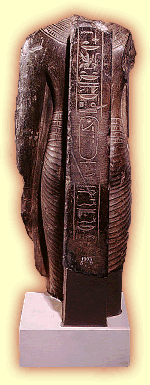|
|
|
|
|
Hieroglyphs, called 'god's words' in Egyptian, were believed in some contexts to have the power to bring to life what they depicted or stated. A funerary formula invoking benefits from a god was enough in itself to ensure the reception of those benefits by the deceased. For example,this shabti of the scribe Qenherkhepshef bears the spell to make it perform any manual labour required of him in the Otherworld. Although the faces of shabtis were standardised, the presence of Qenherkhepshef's name would ensure that the spell worked on his behalf. |
 Shabti of the scribe Qenherkhepshef, about1210 BC |
 Back view of statue of Tutankhamen, about 1330 BC |
Just as hieroglyphs had the power to ensure the survival of
the deceased, to destroy the name of a person was to deprive
them of their identity and render them non-existent. For example,
on the back of this statue of Tutankhamen (1333-1323 BC), his
name has been erased and replaced by Horemheb |
